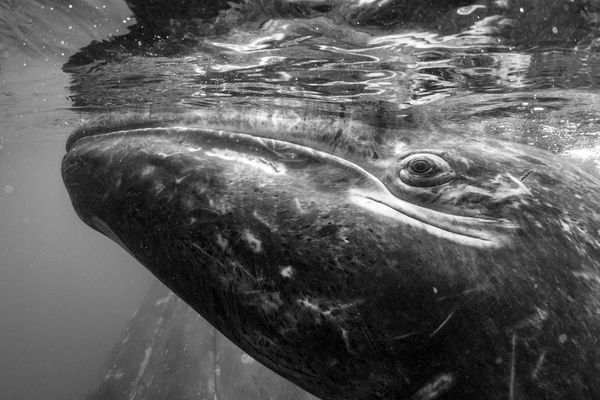
Peter Zeihan: Europe Goes Nuclear
We’ve got two major developments in Eurasia. We’re talking about Ukraine disabling two ships in the Caspian Sea and Poland getting EU approval to build…
Thought Leader: Peter Zeihan

The gray whale is unique. It radiates an air of gentle romanticism; when it exhales, the exhalation often emerges in the shape of a heart. Graced with streaks, splashes, and countless shades of gray, a gray whale’s scarring and natural pigmentation make the perfect ocean camouflage. They appear to be soulful and contemplative and are often seen swimming on the water’s surface, seemingly at peace with themselves and the world around them.
Gray whales lead solitary lives and can migrate as much as 12,000 nautical miles in a single year. Many gray whales are born in the coastal lagoons of Mexico’s Baja California Sur and spend much of their time tacking slowly along the coast between Baja and the Arctic.
A few weeks ago, I was in the waters of Ojo de Liebre lagoon, scouring the horizon for telltale signs of water spouts. I had timed my arrival to coincide with the last mothers and calves to begin the long journey north to more abundant waters. Not all gray whales leave the shelter of Baja’s lagoons at the same time. Mothers with young babies may delay their departure if they feel their calves are not yet strong enough for the voyage. The mothers will drift slowly north, hugging the coastline and feeding while their babies become sturdier swimmers.
 Gray whales are frequently observed traveling alone or in small groups. Large aggregations may be seen in feeding and breeding grounds. Gray whales are frequently observed traveling alone or in small groups. Large aggregations may be seen in feeding and breeding grounds. |
We had chartered several days with a local panga, an open-air, closed-top touring boat unique to that part of Mexico. We didn’t have much luck the first few days. What whales remained seemed to have little interest in me or my camera equipment. Disheartened, I considered calling off the expedition and heading back to the SeaLegacy1, but I decided to stick it out for one last day.
It was a fortuitous decision. We spotted a mother and her calf on the afternoon of what would have been our fourth and final day, and right from the start, these whales seemed keen to play with us. For reasons we might never understand, this pair seemed more trusting and curious than the others. Trust and curiosity are traits gray whales have picked up from generations of interacting with the local fishers. The fishers, in turn, have learned that they can make a better living from tourism than from fishing.
Mexico’s government and community leaders in Baja’s Magdalena Bay and other coastal regions have drawn up firm rules designed to monitor and protect the local population of gray whales so that the whales will keep returning to these lagoons every year to give birth.
 Gray whales make one of the longest annual migrations of any mammal, traveling about 10,000 miles round-trip and in some cases upwards of 14,000 miles. Gray whales make one of the longest annual migrations of any mammal, traveling about 10,000 miles round-trip and in some cases upwards of 14,000 miles. |
The system works both ways. The whales choose whether they want to mingle with sightseers, always on their terms. The tourists, for their part, are in for an experience that can be life-changing. Being so close to these giant sea beings, from the edge of a panga, can only be described as spiritual.
Watching this calf approach, vying for attention like a puppy waiting for its owner, I felt a rush of almost childlike, giddy joy. This was a communion with another creature, an experience unlike any I have felt before with nature. The encounter was silent and pure, their exhalations the only sound to break the silence. We floated alongside them for almost an hour, engines off, feeling the saltwater spray from their spouts and the reverberations of their breathing.
It wasn’t until later, days later, that I realized how truly incredible it had been to film these whales at that moment. I understood the positive impact these tourism operations have, not just on myself, but on every person who experiences this moment for themselves. I had seen how deeply connected the livelihoods of these local communities are with the return every year of these mammoth denizens of the sea.
 International conservation measures were enacted in the 1930s and 1940s to protect whales from over-exploitation, and in the mid-1980s the International Whaling Commission instituted a moratorium on commercial whaling. International conservation measures were enacted in the 1930s and 1940s to protect whales from over-exploitation, and in the mid-1980s the International Whaling Commission instituted a moratorium on commercial whaling. |
The whales are now protected, to a point. The International Whaling Commission passed a moratorium on commercial whaling in the mid-1980s, and the coastal population of gray whales has recovered.
There are still challenges, though. Their migratory patterns take them through some of the busiest shipping lanes and commercial fishing grounds in the world, and the whales are at high risk of becoming entangled in fishing gear. The injuries these whales sustain, their inability to feed, combined with the stress and fatigue from dragging fishing gear over long distances, can result in a slow and painful death.
Now that I am back home on Vancouver Island, I find myself constantly thinking about these whales.
As I look over the Pacific Ocean, I occasionally spot the spout of a migrating whale and I feel a swell of pride. These whales may have been born in the same coastal lagoon where I was just weeks earlier. I think about the long journey home awaiting them.
Gray whales’ feeding habits mirror the seasons. As the hours become shorter in the fall and there’s less daylight, they will once again begin the long journey south. I know that from now on, a small part of me will always be with them.
Peter Zeihan: Europe Goes Nuclear
We’ve got two major developments in Eurasia. We’re talking about Ukraine disabling two ships in the Caspian Sea and Poland getting EU approval to build…
Thought Leader: Peter Zeihan
Dr. Sanjay Gupta’s Top Health Stories of 2025
From the resurgence of measles to a new way to treat pain, 2025 was a challenge for public health while still offering moments of hope. Sanjay…
Thought Leader: Sanjay Gupta
Ian Bremmer: The state of global conflict in 2025
On GZERO World, Ian Bremmer takes a hard look at the biggest global crises and conflicts that defined our world in 2025 with CNN’s Clarissa…
Thought Leader: Ian Bremmer

